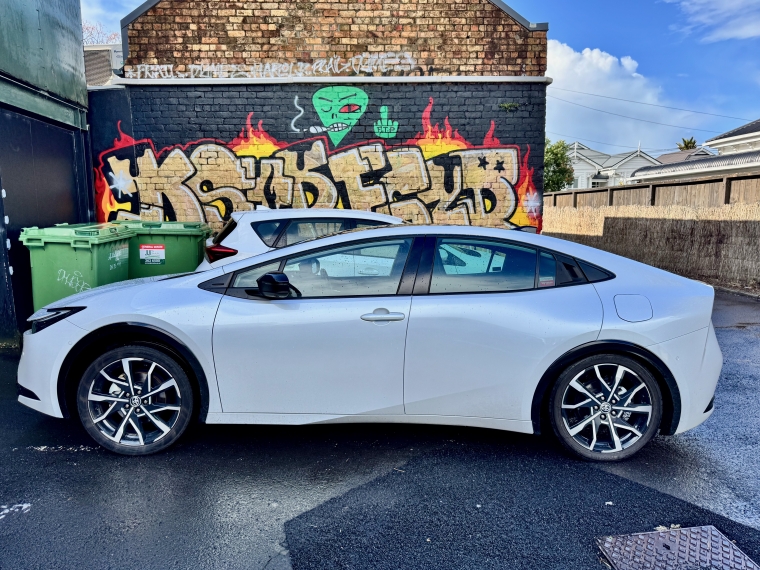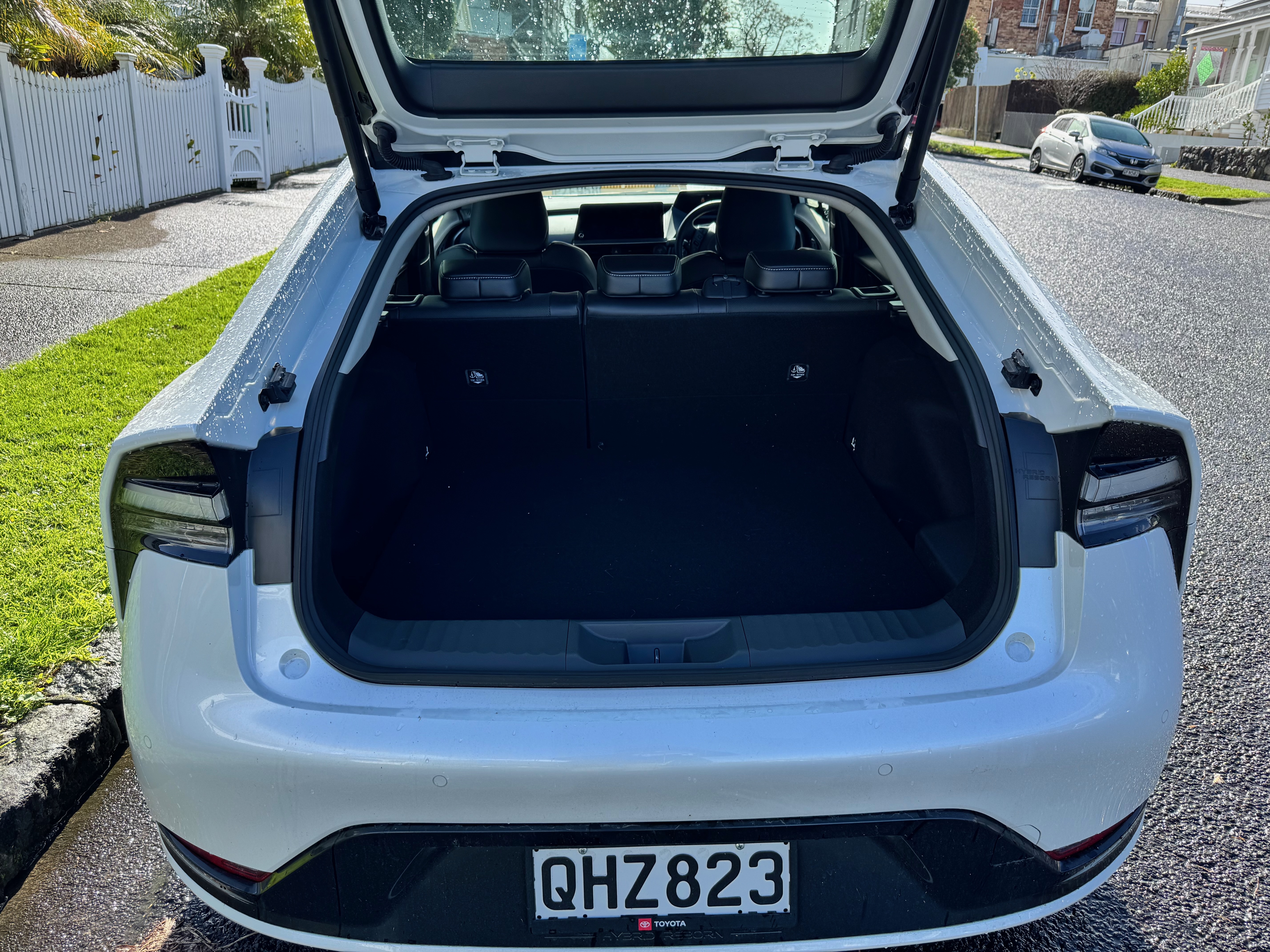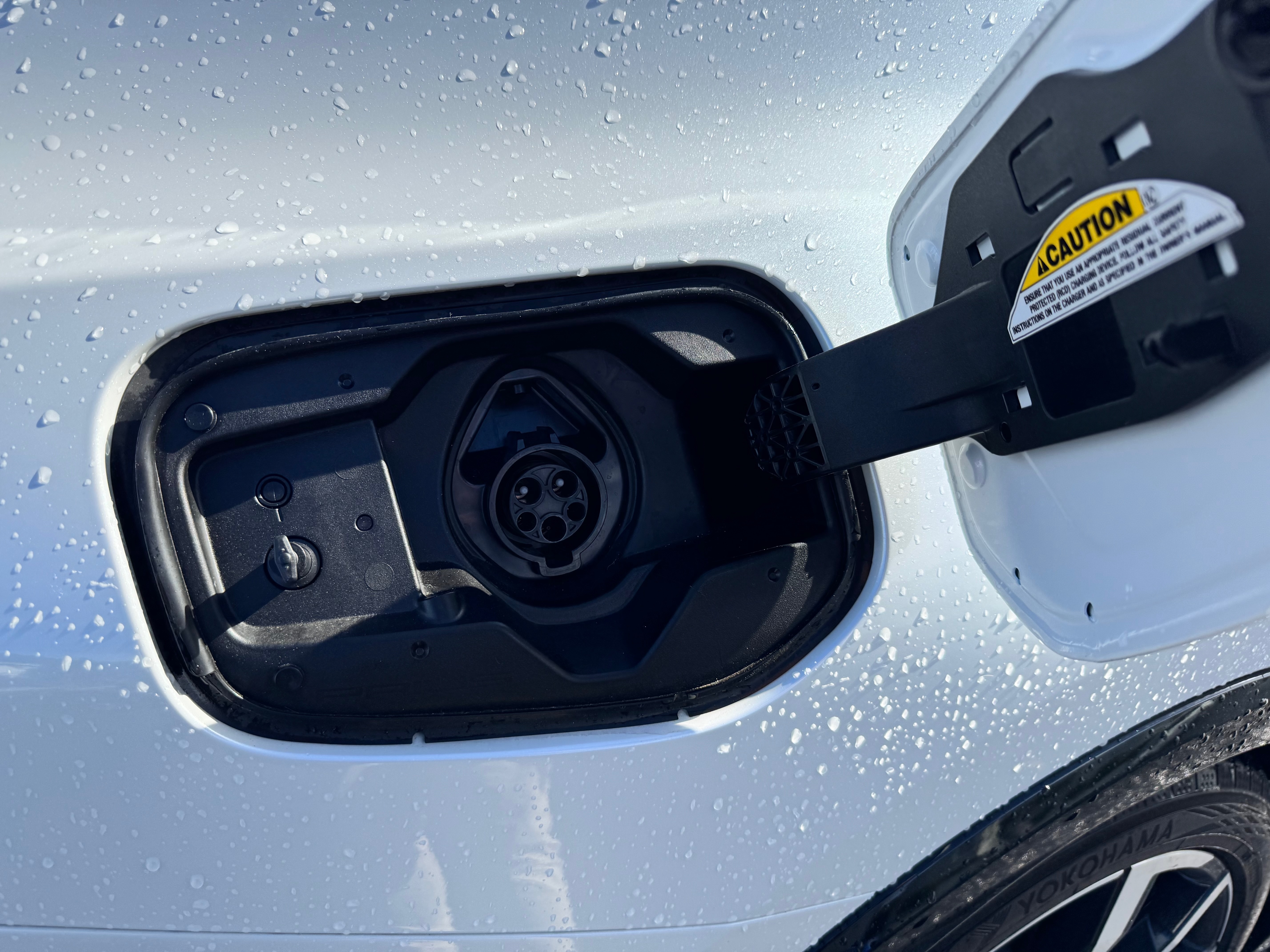
When Toyota New Zealand out of the blue offered a second hand 2023 Signature Class Prius plug in hybrid (PHEV) hatchback to drive for a week, my response was “yes please”. Why? Because the Prius is a curious mix of new car technologies. How well would they work in town and on the highway?
What’s more, it looks great. Yes yes. This is always subjective but Toyota’s recent car designs are a step up from the staid ones from not so long ago, so there was a bit of head turning from the public while whirring past quietly in the Prius.
The 2023 Prius PHEV has low slung looks, being 1.43 metres in height. It’s pretty much a perfect size for a daily Auckland driver at 4.6 metres in length, and 1.78 metres wide. Inside, the Z grade model has what looks like synthetic leather upholstery with heated and ventilated seats; the driver’s one is power adjustable, but not the passenger’s seat. Ah well. Drivers are the important people because they… pilot the car, right?
Other than that, there’s a long list of features like dual climate control, automatic headlights and windscreen wipers, power tailgate, heated steering wheel and dual glass roof (rooves?).

A good complement of Toyota Safety Sense driver aids like Lane Tracing Assistance, and radar adaptive and normal cruise control, emergency braking, pedestrian and traffic detection, forward and rear cameras with good resolution (ditto the in-car screens) and a 360-degree view too.
Wireless Apple Carplay and Android Auto are supported, and there are USB-C and USB-A plugs to supplement the charging slot for smartphones. This didn’t work too well with an iPhone 15 Pro Max that had a case on it.
Despite being an import, most of the menus were in English, although the FM radio frequencies were Japanese, and there's a JBL sound system that sounds OK.
The usual Electronic Toll Collection (ETC) card slot is included. It sits there by the driver’s right knee and doesn’t do anything in New Zealand. At least there’s not the regular ETC voiceover with warning chimes like in so many other Japanese imports.
Since I used Apple and Google Maps for navigation, I completely forgot about the navigation system on the Prius after a few failed tries to make it go. Somewhere there's meant to be an app for the car too, but time, there's no time, and this story will need to be updated when we find out if it'll work on NZ Priuses.
One feature that this driver loves in modern cars is self parking. Isn’t it great how the vehicles can get you into tight slots you’d never dream of trying for yourself? So much so that it can be difficult to get out of them. The Prius does both parallel and perpendicular parking, gently and with millimetre precision, handling the forward and reverse manoeuvring and steering of course by itself.
It does seem to have a penchant for perpendicular parking though, even when the task at hand is to do the parallel thing. Self-parking systems take a while to get used to though. In this case it was no doubt due to operator inexperience and chickening out with Auckland motorists having road-rage nosebleeds of fury because you took a few seconds too long to position the car right for parallel parking.
Oh, and yay! There are buttons and stalks for the controls, including a multi-function steering wheel, so no need to smudge your way through touchscreen menus.
Adding up the hybrid tech, well, sort of
Our assigned PHEV car was a Z-grade model with a two-litre Atkinson cycle petrol engine, and front-wheel drive.
Specifications sleuthing revealed that the system output is 164 kilowatt in total. That’s from a 122 kW electric motor integrated into the transmission, and the petrol which produces approximately 113 kW.
Torque is rated at maximum of 188 Newton metres for the petrol, fairly high up at the 4400-5200 rev range. That’s in addition to the electric motor’s 208 Nm which is instantly available when you set off.
And no, you can’t simply add up the figures of the electric and petrol engines as “there are drivetrain impacts to consider when calculating the total power and torque figures of a hybrid system,” Toyota New Zealand explained.
What the numbers add up to in practical terms is a car that feels fast and responsive in all conditions, in town and on the highway. I didn’t thrash the Prius to see if it was possible to match the 6.7 second to 100 kph acceleration time seen in car publications but something not too far off that number seems achievable.
Toyota NZ has brought in the PHEV, which is apparently the most powerful Prius ever, and the normal hybrid models that have different engine specs, in front-wheel and all-wheel drive variants, the latter with an electric motor for the rear axle as well. The non-plugin hybrids are not subject to road user charges, whereas the PHEV is.
A very relaxed and comfortable drive
Although at first the amount of tech in the Prius (and most other new cars) seem daunting, the sum total of it makes for very relaxed and comfortable driving. This is what the Prius is set up for, and as someone who does regular 600 km roundtrip commutes, it’s a bliss.
It's not a sports car, but handles just fine through the bends at highway speeds. Which to be fair would be amazing if a vehicle didn't do in 2024, what with all the stability and safety systems they come with.
Cabin comfort levels are high, with good seats. The low roof line does eat into headroom in the back, but as an 185 cm adult it was fine to sit there with plenty of legroom. Luggage space is not too bad either, particularly with the rear seats folded down. The floor is high though, limiting space, and there’s a weird non-removable styrofoam insert underneath with storage cubbies.

One of the cubbies stores the tyre repair kit so yep, you’re not getting a spare wheel with the Prius.
The driving aids work well without being intrusive, with the LTA gently keeping you well positioned on the road and nudging the steering wheel accordingly. Set the adaptive cruise, put on a podcast or music, and let the Prius help out with the driving. It seems Toyota designed the Prius PHEV with mainly city driving in mind, but it’s absolutely fine on the open road.
There are four driving modes for the Prius: Eco, Normal, Sport and Custom. Normal seems fine for most purposes, with not heaps difference with the car set to Eco or Sport beyond the steering feeling different, and some very minor effect on the hybrid system operation. This would take longer to explore, and it's possible that spending some time changing the Custom settings is worthwhile. Which is to say, if I had the car longer, I'd fiddle around with the Custom mode settings because that's the kind of person I am.
On battery, the Prius is nearly silent and there’s only a muted growl when the petrol engine kicks in. In normal mode, the Prius will go through the battery first. You don't get to use up all of the electricity though, not directly. Toyota NZ explained it like this:
“The maximum capacity of the PHEV battery is 13.6kWh. There is 10.9 kWh of “disposable” capacity with the remaining 2.7 kWh reserved for instances where there is the chance for the battery to overcharge or be overdrawn. This buffer is providing reassurance that the battery always remains within an optimal capacity range when in use to maximise the battery life.”
At this juncture, it’s worth noting that the battery charging options are a bit… limited. Toyota provides a Level 2 alternating current (AC) charger with each Prius PHEV that you plug into your usual 230 Volt outlet. That way you’ll charge the battery in 7 ½ to 8 hours from empty; the maximum supported charging is 3.6 kW, and you can schedule the time to top up the battery for when power is cheaper.

Home charging is fine generally, but you forgo DC charging top ups on the road like for example the Mitsubishi Outlander PHEV and the BYD Sealion 6 offer.
Switching between EV and hybrid vehicle (HV) modes was seamless, and the electronic continuously variable transmission (eCVT) added to the smooth experience.
Our Prius came with big 19-inch wheels that look really good - and this is said as someone who doesn’t care much about wheels. Surprisingly enough, the road noise in the cabin from the big wheels with stiff, thinnish tyre sidewalls wasn’t bad thanks to Toyota’s sound dampening efforts. Smaller wheels would seem a better option though for the type of car the Prius is; see below.
The costs… uh, it’s a bit complicated
How much financial sense the Prius makes is a bit tricky to work out, as it depends on how the car is used. Heh, what am I talking about? “Making financial sense” and “cars” in the same sentence?
First, the Prius is not cheap. Yes, it is a new-ish upmarket vehicle loaded with features. Plus, it’s a Toyota, and the Signature Class warranties are solid with the battery included for five years. Even so, the indicative pricing Toyota NZ sent of $71,900 is high indeed. That's a common theme for PHEVs unfortunately.
It made the top spec New Zealand-new Camry hybrid that a Toyota dealer in Auckland pointed the writer to look really rather affordable, at $51k. OK, the Camry is a sedan and not a handy hatchback. It's not a PHEV either, and the Prius wins on design and cool factor, but times are tough for the working stiff who have to run cars.
Then there’s our government’s visceral dislike of pure electric vehicles, with the market for them being sunk through the removal of the Clean Car Discount and the introduction of road user charges. The government set the RUCs for plug-in hybrids to $38 per 1000 km (plus that irritating $12.44 admin charge if you pay online, or $13.71 at an agent) instead of $76 per 1000 km, to account for the petrol excise paid with PHEVs.
You’re unlikely to completely avoid tax double-dipping, as in paying both RUCs and petrol excise, but keep that PHEV battery topped up, use as little fossil fuel as possible, and it might pan out cost-wise, particularly for shorter city trips.
Battery fully charged, and with a full tank, there was an indicated 75 km for EV mode, plus 660 km for petrol driving on the 7-inch digital dashboard. The Prius PHEV has a 40 litre tank, and the petrol engine runs on 91 octane. The official fuel economy rating is 5.5 stars out of 6, ditto with the CO2 emissions that are rated at 21g per km.
The indicated petrol only range was for highway driving, and in town it dropped quite a bit, maybe by 50-60 km.
Meanwhile, the EV range on a windy, hilly country road won’t be as good as what the Prius indicates at the start of the drive, but it was easy to reach 60 to 65 km, which is useful.
Running in hybrid mode with both the electric and the petrol systems, the car used 4.2 litres per 100 km (indicated), increasing to 5.3 litres up Northland’s long steep hills. Bit of a worst-case scenario but what I got was pretty good, with two people in the car plus luggage, and in atrocious weather conditions with the air conditioning on to stop the windows from misting up.
The indicated EV range seems possible to achieve if you’re gentle with the accelerator so that’s many people's daily commute on battery right there.
You can also charge the battery with the petrol engine through a button press, but that seemed like an expensive way to do it compared to plugging it in at home.
Speaking of charging the car on the run, the battery regeneration in normal mode seemed a bit meh, adding just a few kilometres while coasting downhill.
There’s a B mode that adds battery regen which helps, but it doesn’t extend to one-pedal driving with the accelerator only, so you have to touch the brakes to stop the car fully. It’s possible there’s a way to set the regen to the maximum that the B mode offers somewhere in the menu system. I couldn’t figure out how to make it stick though.
Also, you have to get out of B mode for the adaptive cruise control to work so you don't get that much mileage out of it.
Toyota could perhaps be helpful with the electric driving side of things, and offer to swap the lovely 19-inch alloy wheels for the 17-inchers that the Prius can also be equipped with. Apart from making the wheels less prone to damage, a swap to smaller wheels would likely improve ride comfort and importantly, bump up Toyota's official EV-only range to 105 km from 87 km.
This might get you a real-world range of up to 85 to 90 km, with gentle driving, on battery only. Swapping to smaller wheels yourself is unlikely to make sense financially, but please feel free to correct yours truly on that.
Other than possibly leading to overthinking the economics of car ownership, the XW60 platform Toyota Prius PHEV ticks a lot of boxes for many drivers if their budget stretches to one. Comfortable, economical, feature-rich, enough space without being a giant vehicle and it moves along at a decent clip as well. But do keep the battery charged.
13 Comments
These are a great looking car - leaps and bounds ahead of the original Prius in the styling department, and I'd be looking at one if on the market for a new sedan shape car ... although I think the OG Prius is a bit of a future classic insomuch that it was one of the original eco cars, and is a cultural icon (only problem is you can't drive one of those now without everybody thinking you're an Uber driver).
The pricing is well adrift, when I can buy a new Mitsubishi Outlander PHEV for $63,000, and a MG HS from $51,000 - particularly given that they are possibly better suited to coping with our rough and degrading roads.
The RAV4 PHEV signature class might be a better comparison - but they're still too expensive, given Toyota's policy of not negotiating on price.
And people like Jeep (Stellantis) and others are discounting PHEVs to shift them - the Rengade 4xe starts at $43,000...
The pricing is well adrift, when I can buy a new Mitsubishi Outlander PHEV for $63,000, and a MG HS from $51,000
But
In 10 years, the Toyota will have retained more of it's value.
In 10 years most people will be wondering why you would buy a passenger car with a combustion engine.
Heavy vehicles might be a bit further away, but battery tech is good enough for passenger cars already, in 10 years it'll be ubiquitous.
Its good enough for passenger cars for a specific demographic.
For anyone say, that has to park on the street or travel extensively as examples, the tech has a way to go. The next hybrid Corolla on the other hand, is projected to do 2000ks a tank.
Maybe - but from a rather higher baseline, rather than the inflation-eroded value in some years time. And $30k higher than the new Jeep? That's a lot of depreciation.
A 10 year old Jeep is almost worthless.
Toyotas cost what they do, because they spend more on engineering, so their cars are designed to last 100s of thousands of kilometers.
Luxury cars get money spent on bleeding edge tech that the owners move on after 3-5 years, for the latest bleeding edge tech.
A whole bunch of also rans (think anything by Stellantis) are manufactured to a price that gives affordable, yet disposable motoring. If you don't care about long term ownership, reliability or resale, buy one of those.
They need to knock $20k off the price. There are several new full EVs for less, or for $5k more you can get a new long range model 3 which knocks the pants off the Prius in every way.
And it looks like it's got a boot full of bricks, the front end needs lowering an inch to remove that squat.
I don't think this is meant to compete directly with EVs.
It's at the top end of non European hybrids, for people that prefer/need a hybrid, instead of an EV.
It'll likely be 10 years before I can replace my work vehicle with an EV, if ever. A hybrid is probably a couple years away.
https://www.trademe.co.nz/a/motors/cars/nissan/leaf/listing/4820703778?…
$37,590
Was $72,990
https://www.trademe.co.nz/a/motors/cars/nissan/leaf/listing/4824514912?…
$30,590
Was $63,990
Both new Nissan Leaf"s
That Jap import Prius is hugely overpriced
I’d way rather have a Tesla Y or 3 for less money than that.
But the best value EV must surely be the MG ZS. Those things look incredible value and with a 7 year warranty as well.
What will the Leafs range be in 10 years? I can't believe they didn't add thermal management to their batteries when they went to that latest shape.

We welcome your comments below. If you are not already registered, please register to comment
Remember we welcome robust, respectful and insightful debate. We don't welcome abusive or defamatory comments and will de-register those repeatedly making such comments. Our current comment policy is here.